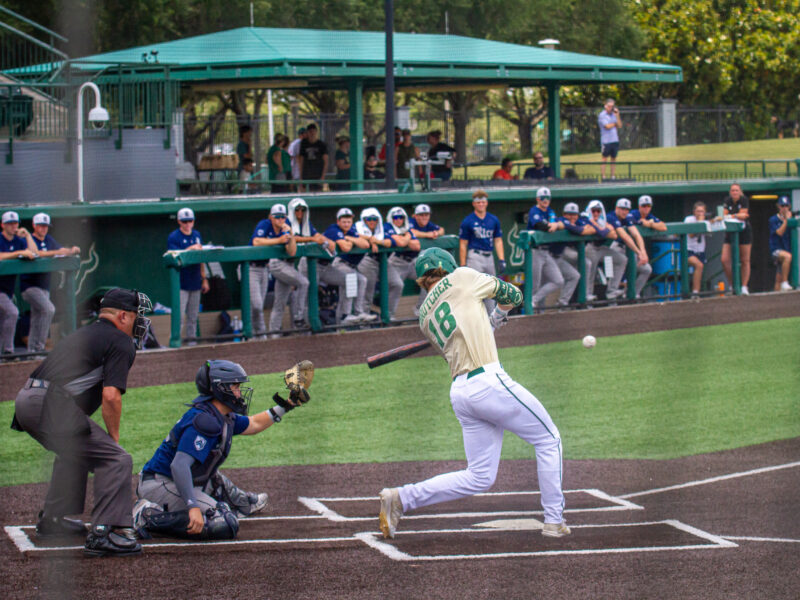Two people squat by the berimbau player at the head of the roda, the circle of people playing instruments, singing or clapping. Before entering the circle, the two respectfully greet each other. To the rhythm of the berimbau, the toque, the two players begin their performance.
Kicks fly into the air. One player moves, then the other. It is a dialogue of movement. The opponents watch each other closely, and they never get hit unless one of them attempts trickery. Spins, jumps, sweeps, drops to the ground, flips, handstands and cartwheels are performed to dodge the opponent’s strikes. This art, called capoeira, appeared a long time before the fighting scenes from the first Matrix became popular.
There is no capoeira school in St. Petersburg. Instead, local capoeiristas gather at the Suncoast Cathedral Church on 62nd Avenue North every Tuesday night to practice this Brazilian art of music, dance and fighting.
Cory Hekimian-Williams and Andrea Mendolia, recently married, are long-time capoeira students. Mendolia was involved in the creation of St. Petersburg’s capoeira following by chance.
“The capoeiristas refer to it as ‘playing,’ not ‘fighting,’” Hekimian-Williams said. However, capoeira is, primarily, a martial art that interweaves fighting with dance, acrobatics, song and music by traditional instruments.
Three years ago, Mendolia met a man in a St. Petersburg park who “was wearing all white and playing the berimbau, and doing crazy flips,” she said.

He turned out to be a Brazilian by the name of Bocoió. Mestre Bocoió is what they began to call him when, with Mendolia’s assistance, he established St. Petersburg’s first capoeira school.
According to Hekimian-Williams, African slaves brought to America by Portuguese colonialists originally developed Capoeira in Brazil. Capoeira flourished in Salvador da Bahia, a major seaport where slaves were traded to labor on tobacco, sugar cane and coffee plantations.
“As slaves, they weren’t allowed to practice martial arts,” Hekimian-Williams said. “So, they didn’t call it martial arts. They called it dance. But, in reality, they were training to defend themselves.”
Capoeira was “looked down upon, as a slave martial art,” Hekimian-Williams
As it spread through Brazil, the government outlawed capoeira. Its legalization occurred when a Mestre by the name of Bimba made the art structured, labeled the moves and opened a school.
“He formalized it so that it could be taught,” Hekimian-Williams said. “He is now considered the father of capoeira.”
The music is very important in capoeira.
“We have to learn to play instruments. We had to learn Portuguese songs. All of it encompasses capoeira. You can’t have one without the other,” Mendolia said.
“And you have to play the berimbau well to be considered a good capoeirista,” Hekimian-Williams added.
The berimbau is a wooden bow about 1.5 meters high with a caraca, or gourd, attached for resonation. The bow is held by one hand while the other holds the baqueta, a wooden stick, for stringing.
The berimbau is called “the soul of capoeira” by its players, according to Mendolia. It is the instrument that sets the rhythm of the play and decides the speed and the technique used in a game. Other instruments include the pandeiro (hand drum), atabaque (tambourine) and agogô (double bells).
When the toque is slow, the style is called Angola, and the players move slower, stay close to the ground, “like seaweed intertwining in water,” Mendolia said.
When the tempo rises, it becomes a style called Regional. Players speed up and intensify their movements. They may jump and incorporate a variety of high kicks, as well as a wider range of acrobatic movements.
Capoeira fighting involves more kicks than arm techniques. The hands are usually held close to the face for shielding, or used for balance in acrobatic movements.
“It’s a striking martial art, not a grappling martial art, the opposite of jujitsu,” Hekimian-Williams said. “If you take [your opponent] down, you kick and run away.”
Capoeira is “a very showy martial art,” Mendolia said. It is very playful, and a lot of trickery and malicia, is involved. “Maybe you do a certain kick all the time and [your opponent] start[s] expecting it and dodging, and all of a sudden you come at them with something different,” Hekimian-Williams said.
According to Hekimian-Williams, capoeira teaches body control, balance and acrobatics. It also improves flexibility and provides exposure to the Brazilian culture.
“It’s a good workout.” Mendolia said. “It’s a lot more fun comparing to other martial arts. You get people clapping and singing. It’s a different energy. It’s very social. I like doing different things, and this one seemed very weird. It challenged me in different ways.”
Unfortunately, the first school in St. Petersburg was short-lived. Without a goodbye, Mestre Bocoió disappeared from his students’ lives as abruptly as he showed up. The students were left without a leader. Some began driving long distances to capoeira schools in Tampa and Sarasota, and others continued searching for opportunities to practice locally.
Eventually, finding an interested group in St. Petersburg, Mestre Pica Pau began commuting from Tampa to lead the Tuesday class. They do not have their own studio, but the classes are free, and the students get the capoeira experience without having to travel 50 minutes away.
The St. Petersburg capoeira group is very tight-knit. All of them were present at Hekimian-Williams and Mendolia’s wedding in September.
The bride and groom figurines on their wedding cake were uniquely shaped – the groom was shown performing a kick while the bride was performing a matrix backward bend in her wedding dress. Capoeira class was where the couple first met, and they continue to carry their passion through the years.



